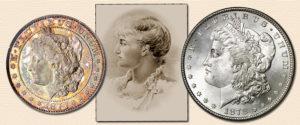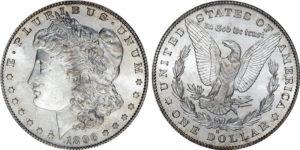Anna Williams
The New York Mail and Express claimed that her face was “known to more people than that of any other woman of the American continent.” Many were the actresses and socialites who coveted the honor. But in her later years Anna W. Williams dismissed the matter as “an incident of my youth.”

Had she been paid on a royalty basis for the use of her portrait, Williams would have been the wealthiest woman in America. “Every man, woman or child who has a silver dollar carries the handsome profile of the Philadelphia schoolteacher, Miss Anna W. Williams,” the Mail and Express said. “Her classic features have been stamped upon millions of the silver disks.”
It all began with the passage of the notorious Bland-Allison Act of February 22, 1878, which authorized the secretary of the Treasury to purchase two to four million dollars worth of silver each month to be coined into silver dollars. Not since 1873 had silver dollars been minted for domestic use, and even then the Seated Liberty design was considered outmoded. Treasury officials decided that a fresh, vibrant design was needed for the new silver dollar as the country entered the most dynamic period in its history.
Certainly there was no shortage of sources of inspiration. The official Illustrated Catalogue of the Centennial Exhibition, Philadelphia, 1876, has a frontispiece showing Columbia in a liberty cap giving wreaths to three other female figures representing Europe; Asia, and Africa, while with her other hand she holds an American flag.
Frank Leslie’s Historical Register of the United States Centennial Exposition, 1876, opening with a chromolithograph of America clad in the stars and stripes, an elaborate helmet on her head, her costume covered with jewels.
It is entirely possible that George T. Morgan saw these images. In the early part of 1876 the Treasury Department secured, through communication with the Royal Mint of London, the services of  the clever young designer and engraver. Upon his arrival in the United States, Morgan was assigned to the Philadelphia Mint, where in 1877 he created several varieties of pattern half dollars. His first major task was to prepare designs for a new silver dollar, which seemed likely to win authorization as the silver interests lobbied Washington for favorable legislation.
the clever young designer and engraver. Upon his arrival in the United States, Morgan was assigned to the Philadelphia Mint, where in 1877 he created several varieties of pattern half dollars. His first major task was to prepare designs for a new silver dollar, which seemed likely to win authorization as the silver interests lobbied Washington for favorable legislation.
After intensive labor, Morgan completed the design for the reverse side of the coin. The elements themselves, an eagle and wreath, had been used on his pattern half dollars of the previous year. As executed by Morgan, they displayed a decidedly different interpretation than previous U.S. coins. The slender eagle with raised wings may have lacked anatomical perfection, but it did embody the concept of freedom without wearing the ridiculous shield seen on the birds engraved for other coins.
Morgan began with the reverse side of the coin out of necessity. Treasury officials wanted the designs readied as quickly as possible, and Morgan was not certain what he wanted to engrave for the obverse side. Perhaps he, too, had tired of the Seated liberty design, derived from the symbolic figure of Britannia with which he was so familiar. After due consideration, he decided to portray liberty as a goddess. Too much of a realist to be satisfied with a mere product of fancy, he determined the head should be a representation of a real American girl. Selected was one of his own designs from an 1877 pattern half dollar. Therein lies a story. . .
Upon his arrival in America in 1876, Morgan found a sympathetic friend in famous painter Thomas Eakins, who shared his penchant for realism. Eakins, a friend of the Henry Williams family of Philadelphia, introduced Morgan to Miss Anna Willess Williams, Henry’s daughter. Morgan was immediately impressed with her face and studied it carefully.
Anna herself was an art student and understood the importance of finding a suitable model. After much persuasion by Eakins and her other friends, and the promise that her role as a model for a coinage design would be kept secret, she consented to serve as Morgan’s model. Altogether there were five sittings at Eakins’ home in November 1876.
Morgan was delighted with his model and said that her profile was the most nearly perfect he had seen in England or America. Williams’ complexion was fair, her eyes blue, her nose Grecian and her hair, said to be her “crowning glory,” was of golden color, abundant in quantity and light of texture. It was worn in a becoming coil, perhaps resembling Morgan’s design for one type of the $4 gold piece, or “Stella.”
Morgan later decided to add a cap as ornamentation befitting the “goddess” of Liberty. This design, used on pattern 1877 half dollars, was accepted for production of silver dollars, and in 1878 the Philadelphia, San Francisco, and Carson City mints turned out a total of more than 12 million silver dollars.
Williams’ role as the model for the design remained a secret only until the summer of 1879, when a Philadelphia reporter revealed that she was in fact the “Silver Dollar Girl.” The colorful name struck a responsive chord in the public. Williams was besieged with thousands of letters and visitors, which troubled her greatly. There were even offers of lucrative stage engagements, but Anna rejected them in favor of a teaching position at the House of Refuge. In 1891 she accepted a $60-a-month job as teacher of kindergarten philosophy at the Girls’ Normal School.
Although the glare of publicity slowly faded, the Ladies’ Home Journal still considered Williams a fascinating subject when it published her photograph in 1892. Four years later, the announcement that the goddess of Liberty was about to be married brought Williams into the limelight again.
“Miss Williams is a decidedly modest young woman,” the New York Mail and Express reported. “She resides on Spring Garden Street, not far from the school in which for years she has been employed as an instructor in philosophy and methods in the kindergarten department. She is slightly below the average height, is rather plump, and is fair. She carries her figure with a stateliness rarely seen, and, the pose of the head is exactly as seen on the silver dollar. The features of Miss Williams are reproduced as faithfully as in a good photograph.”
Maybe it was the notoriety that caused the engagement to be broken. At any rate, the marriage never took place and Williams became increasingly reluctant to tell the story of how she came to be the model for the silver dollar. She much preferred to talk about her work as supervisor of Philadelphia’s kindergarten schools.
Williams had retired from the school system when in December 1925 she sustained a fall and was confined to bed. On April 17, 1926, a stroke claimed the life of the famous “Silver Dollar Girl.” The passing of Williams was noted by The Numismatist, which reported in May 1926:
“An obituary told of a Philadelphia lady whose portrait had been reproduced hundreds of millions of times: ‘Miss Anna W. Williams, of Philadelphia, a retired public school teacher, whose profile was used in preparing the design of the standard silver dollar in 1878, died in her native city on April 17. Death was due to apoplexy, induced by a fall she sustained last December and she had been confined to her bed since.
“‘The statement has been frequently made that the head on the standard silver dollar was that of Miss Williams. This statement is not strictly true. Miss Williams possessed a Grecian profile, which was considered almost ideal for a typical head of Liberty, and chiefly on that account she consented to pose for the engraver while preparing the design. This is borne out by the fact that the entire head is much more mature in appearance than would be expected in a girl 18 years old. That was her age at the time she posed. . .
“‘Miss Williams was born in Philadelphia. Her mother was a Southerner, the daughter of Dr. Arthur N. Willess of Maryland. His daughter married Henry Williams of Philadelphia, and went with him to that city.'”
The statement below was found in a letter in the Morgan estate offered as lot 1130 in the May 10-11, 2002 Craig A. Whitford Numismatic Auction sale which disputes the long held belief about Anna Williams. The following is quoted from that letter.
“Father always said no matter how many models posed for him, that he never bid any & that he just made up the obverse himself…”
Credit: Bowers and Merena

